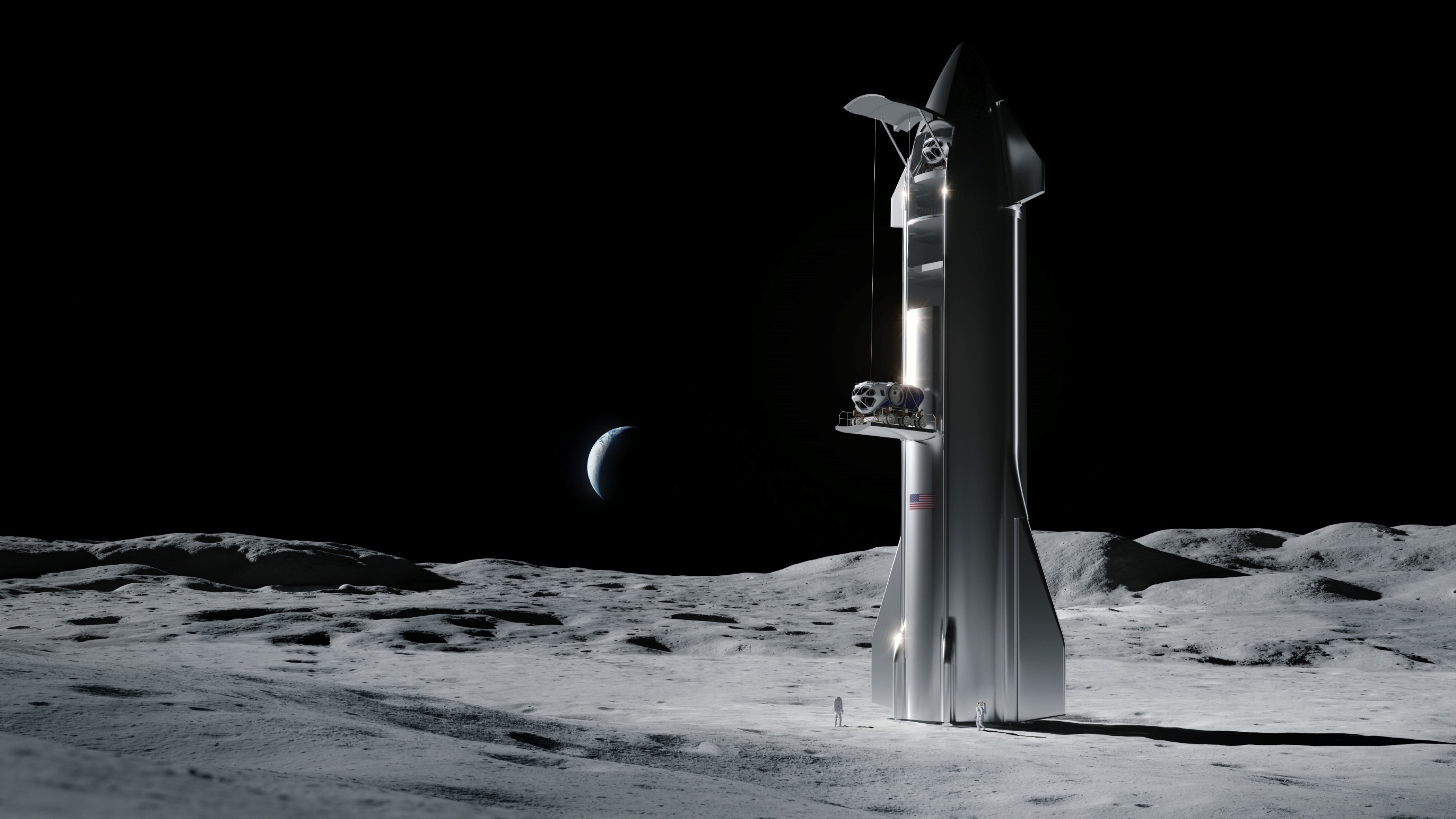
SpaceX's huge Mars-colonizing Starship vehicle could make its first extraterrestrial touchdown just three short years.
SpaceX is one of five companies that are newly eligible to deliver robotic payloads to the lunar surface for NASA, via the agency's Commercial Lunar Payload Services (CLPS) program. SpaceX proposes to do this work with Starship and Super Heavy, the reusable spaceship-rocket duo that the company is developing primarily to help humanity become a multiplanet species.
And Starship could start putting NASA payloads down on Earth's nearest neighbor quite soon, if all goes according to plan.
"We are aiming to be able to drop Starship on the lunar surface in 2022," SpaceX president and chief operating officer Gwynne Shotwell said during a NASA-organized CLPS teleconference Monday (Nov. 18).
Video: Watch NASA Explain New Private Moon Lander Picks
Related: SpaceX's Starship and Super Heavy Mars Rocket in Pictures
SpaceX is not guaranteed to fly a CLPS mission that year, or any year. SpaceX is just eligible now to bid on NASA lunar delivery services; it will still have to beat out the rest of the CLPS pool, which is now 14 companies strong, for each moon contract.
And each mission that Starship flies under the CLPS banner will almost certainly ferry gear for a variety of customers. Starship is capable of carrying 110 tons (100 metric tons) to the moon's dusty gray surface on each trip, Shotwell said, and it's hard to imagine NASA filling out that manifest by itself.
Get the Space.com Newsletter
Breaking space news, the latest updates on rocket launches, skywatching events and more!
NASA views CLPS as a key enabler of its Artemis program of crewed lunar exploration, which aims to put two astronauts, including the first woman, on the moon by 2024 and establish a long-term human presence there by 2028.
Commercial spacecraft will land hardware and experiments — such as NASA's water-ice-mapping Volatiles Investigating Polar Exploration Rover (VIPER) — that pave the way for these astronaut pioneers, agency officials have stressed. And buying a ride on private craft, rather than developing and building its own landers, will save the agency a great deal of money, NASA officials said during today's telecon.
SpaceX is excited about the CLPS partnership as well. Starship was always designed to carry people, but early uncrewed efforts such as communication-satellite launches, CLPS flights and cargo missions to the Martian surface will prove out the vehicle, Shotwell said.
"CLPS is a great piece of what we want to get done with Starship," she said today.
SpaceX does have one crewed Starship mission on its docket — a flight around the moon booked by Japanese billionaire Yusaku Maezawa, who plans to take a handful of artists with him. That mission is targeted for 2023.
There are big Starship milestones coming in the near future as well. SpaceX founder and CEO Elon Musk recently unveiled a shiny new full-size prototype of the vehicle, known as Starship Mk1, which could start making 12-mile-high (20 kilometers) uncrewed test flights in the next few months.
The other four companies that joined the CLPS pool today are California-based Ceres Robotics and Tyvak Nano-Satellite Systems Inc.; Sierra Nevada Corp. of Colorado; and Washington-based Blue Origin, which will use its Blue Moon lander.
The other nine CLPS-eligible companies were announced in November 2018. Two of them — Astrobotic and Intuitive Machines — are scheduled to deliver NASA science gear and a variety of other payloads to the lunar surface in July 2021.
NASA is also looking to the private sector to build the crewed Artemis lander. The agency selected 11 companies this past May to conduct studies and build prototypes, and this pool had to submit detailed proposals by Nov. 8. NASA is expected to pick up to four finalists early next year.
- Moon Rush: Private Lunar Lander Plans
- SpaceX's Starship May Fly for Just $2 Million Per Mission, Elon Musk Says
- Here's Where Commercial Landers Will Land on the Moon for NASA
Mike Wall's book about the search for alien life, "Out There" (Grand Central Publishing, 2018; illustrated by Karl Tate), is out now. Follow him on Twitter @michaeldwall. Follow us on Twitter @Spacedotcom or Facebook.

Join our Space Forums to keep talking space on the latest missions, night sky and more! And if you have a news tip, correction or comment, let us know at: community@space.com.

Michael Wall is a Senior Space Writer with Space.com and joined the team in 2010. He primarily covers exoplanets, spaceflight and military space, but has been known to dabble in the space art beat. His book about the search for alien life, "Out There," was published on Nov. 13, 2018. Before becoming a science writer, Michael worked as a herpetologist and wildlife biologist. He has a Ph.D. in evolutionary biology from the University of Sydney, Australia, a bachelor's degree from the University of Arizona, and a graduate certificate in science writing from the University of California, Santa Cruz. To find out what his latest project is, you can follow Michael on Twitter.
-
TEAMSWITCHER I wish Elon Musk would stop with these totally insane estimates for Starship. Imagine just one BFR fist stage crash would destroy 47 Raptor engines and set the project back years. And the second stage is no less complicated than a Space Shuttle.Reply









